Shulgi of Ur › Teishebaini » Ancient origins
Articles and Definitions › Contents
- Shulgi of Ur › Who Was
- Teishebaini › Antique Origins
Ancient civilizations › Historical and archaeological sites
Shulgi of Ur › Who Was
Definition and Origins
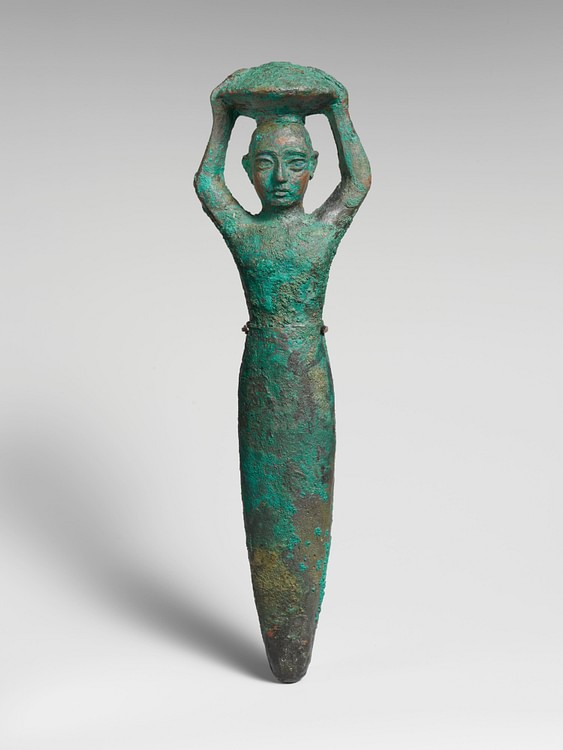
Shulgi of Ur (2029-1982 BCE) is considered the greatest king of the Ur III Period in Mesopotamia (2047-1750 BCE). His father was Ur-Nammu, who founded the Third Dynasty of Ur and helped to defeat the occupying forces of the Gutians, and his mother was a daughter of King Utu-Hegel of Uruk (her name is not known) who first led the uprising against the Gutian occupation. Shulgi inherited a stable kingdom after his father was killed in battle with the Gutians and proceeded to build upon his father's legacy to raise Sumer to great cultural heights. A literate man, he reformed the scribal schools and increased literacy throughout the region. He allocated funds for the continued maintenance of the cities, improved the existing roads and built new ones, and even instituted the first roadside inns so that travelers could stop, rest, eat, and drink as they traveled.He declared himself a god during his lifetime and seems to have been worshipped by the people following his death. His reign is well documented as he had many scribes making inscriptions of his accomplishments but this documentation has been challenged on the grounds of inaccuracy. While it does seem clear that Shulgi reigned well, the majority of the documents relating to the details of his rule were those he ordered to be set down. Later chroniclers would accuse him of impiety and falsification of records, but the archaeological evidence seems to support his version of his reign fairly well.
IN A SINGLE DAY, SHULGI RAN 200 MILES (321.8 KM) THROUGH A GREAT STORM IN ORDER TO OFFICIATE AT RELIGIOUS FESTIVALS IN UR AND NIPPUR.
EARLY REIGN & SHULGI'S RUN
Ur-Nammu's rule had stabilized the region and enabled it to prosper following the expulsion of the Gutians and, thanks to the poem “The Death of Ur-Nammu and His Descent to the Underworld”, he had become an almost mythic hero shortly after his death. His successor might be expected to have struggled to distinguish himself from the former's rule, but this does not seem to be the case with Shulgi. In order to ensure the stability of his kingdom, he created a standing army which he formed into specialized units for specific military purposes (an infantryman was no longer just a `foot soldier' but specialized in a certain tactic, formation, and purpose on the field). He then drove this army against the remaining Gutians in the region to avenge his father's death and secure the borders. To raise money for his army, he initiated the unprecedented policy of taxing the temples and temple complexes which, though it may have made him unpopular with the priests, could have bolstered his popularity among the general populace who did not have to suffer an increase in taxation.
The historian Bertman writes, “Ur-Nammu's imperialistic dreams were fulfilled by his son Shulgi” in the expansion of the Kingdom of Ur from southern Mesopotamia near Eridu up the Tigris River valley to Nineveh in the north (57). This area corresponds roughly to modern-day Kuwait in the south to northern Iraq. The kingdom was maintained efficiently through the unified central administration instituted by Ur-Nammu, which Shulgi improved upon, and was protected and enlarged by the standing army which, since it needed no mobilization, could respond quickly to any disturbance on the borders. With his state secure, Shulgi could devote himself to encouraging art and culture, as his father had done.
He introduced a national calendar and standardized time-keeping so that the whole of his kingdom recognized the same day and time, replacing the old method of different regions reckoning dates and times in their own way. He also instituted agricultural reforms and standardized weights and measures to ensure fair trade in the market place. Prior to Shulgi's reforms, prices varied – sometimes widely – between trade goods in Ur and the same goods in Nippur. All documents were written in Sumerian (instead of the traditional state language, Akkadian), perhaps in an effort to differentiate Shulgi's reign from those of the past. Even so, he seems to have purposefully presented himself to his subjects as a new Naram-Sin of Akkad, the last great ruler of the Akkadian Empire. Ur-Nammu had also understood the value of linking his reign to that of the legendary Akkadian kings, but Shulgi went further in proclaiming himself a god, as Naram-Sin had also done, and signing his name to documents with the divine determinative.
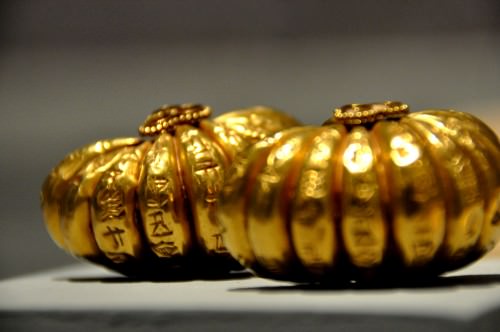
Golden Earrings From King Shulgi
While his accomplishments were many, he still seems to have felt that he was merely carrying on the policies and building projects instituted by his father. The historian Kriwaczek writes, “Construction work on Ur-Nammu's ziggurats continued well into his son's reign, which left Shulgi with the problem of how to establish his own superhuman persona in his people's awareness. He chose to run” (156). In a single day, Shulgi ran from Nippur to Ur, a distance of 100 miles (160.9 kilometres), in order to officiate at the religious festivals in both cities, and then ran back from Ur to Nippur; completing a run of 200 miles (321.8 kilometres) in one day. His motivation in making the run is made clear in one of his inscriptions:
So that my name should be established for distant days and never fall into oblivion, that it leave not the mouth of men,That my praise be spread throughout the land,That I be eulogized in all the lands,I, the runner, rose in my strength, all set for the courseFrom Nippur to Ur,I resolved to traverse as if it were but a distance of one `double-hour'Like a lion that wearies not of its virility I arose,Put a girdle about my loinsSwung my arms like a dove feverishly fleeing a snake,Spread wide the knees like an Anzu bird with eyes lifted toward the mountain (Kramer, 286).
The run certainly accomplished its objective, since Shulgi was associated with the event, and with great stamina, in later chronicles. His courage and determination were also praised because his run took place in the midst of a great storm. His inscription continues: “On that day the storm howled, the tempest swirled/The North Wind and the South Wind roared violently/Lighting devoured in heaven alongside the seven winds/The deafening storm made the earth tremble” (Kramer, 287).So famous, in fact, did Shulgi become for his run that he became a popular figure featured in erotic poetry throughout Mesopotamia not long afterwards and was noted for his virility and stamina as the lover the goddess Inanna. Regarding the famous run, Kriwaczek writes:
Could he really have done it? An earlier generation of Assyriologists thought the achievement impossible, dismissing it as fiction. More recent consideration, however, suggests otherwise. An article in the Journal of Sport History quotes two relevant records: `During the first forty-eight hours of the 1985 Sydney to Melbourne footrace, Greek ultra-marthoner Yannis Kouros completed 287 miles. This impressive distance was accomplished without pausing for sleep.' In the 1970's a British athlete running on a track completed 100 miles in a time of eleven hours and thirty-one minutes. There is no reason to believe that the Sumerians were any less athletically able.Theirs was, after all, a far more physical world than is ours: speed, strength, and stamina would have been much more important to them that they are to us (157).
Shulgi's run spread his fame across the land, as he had hoped it would, and distinguished his reign dramatically from his father's. While Ur-Nammu had presented himself to his people as a father-figure guiding his people, Shulgi claimed the status of a god. He made his run in the seventh year of his reign and, from then on, was able to do as he pleased. It was customary in Mesopotamia to name years after great feats accomplished by the king, usually military victories, and the year of Shulgi's run was thereafter known as 'The Year When the King Made the Round Trip Between Ur and Nippur in One Day'. The story of his run was inscribed shortly after the event, and scribes were sent throughout the kingdom to recite it in temples and present him to the people as an even greater king than his father had been.
LATER REIGN & CONTROVERSY
His public relations campaign was a great success. The Mesopotamian Chronicles describe Shulgi as `divine' and `the fast runner' and tell how he generously provided food for the cities, specifically the sacred city of Eridu. He was brother to the sun god Shamash and husband of the goddess Inanna, according to hymns and songs. When he decided to expand his kingdom to the north, the army followed him on campaign without question, and took the region of Anshan (modern-day western Iran).Both his continued policies of taxation of the temples and temple complexes and the standardization of weights, measure, time, and day throughout his kingdom had robbed the various cities of their regional identities and, to a lesser degree, their economic independence (the financial factor seems fairly negligible since many cities continued to prosper economically after the fall of Ur), and yet there is no evidence of domestic strife or reference to revolt in the records of his reign.

Stone Hair and Headdress of the God Lamma
This peaceful and prosperous version of Shulgi's administration, however, has been challenged because first, as already noted, the history comes from state-issued documents and, more importantly, later writers claimed that Shulgi had purposefully falsified those documents to present himself as the greatest of the kings of Mesopotamia. The same chronicles which present the king as divine also state that “Shulgi, the son of Ur-Nammu, provided abundant food for Eridu, which is on the sea shore.But he had criminal tendencies and the property of Esaglia and Babylon he took away as booty […] caused to consume his body and killed him” (CM, Tablet A, 20:28-30). Another passage from the Chronicles claims that during Shulgi's reign he “composed untruthful stele, insolent writings, concerning the rites of purification for the gods, and left them to posterity” (CM 27). Both of these would have been very serious offenses to the Mesopotamian sensibility, of any time in the region, which held the accurate recording of the past a matter of enormous significance. The claim that Shulgi took the property of the Esaglia (the temple) at Babylon is serious enough, since the temple goods belonged not to the particular city but to the god of that city, but then to lie about it in written form and present these lies as genuine history would have been intolerable.
The Mesopotamian Chronicles (also known as the Babylonian Chronicles) are a history of the activities of the kings of Mesopotamia compiled by scribes at some point in the 1st millennium BCE from older sources. While scholars have long believed they were composed at Babylon, there is reason to believe they were assembled at different sites by different scribes under the direction of the Assyrian Empire, probably Ashurbanipal of Nineveh. It is entirely possible, even quite likely, that these later scribes, writing from a certain point of view and wishing to advance their own agenda, edited or omitted certain details from the past in composing the chronicles, but it is unlikely that they would have completely fabricated incidents and passed them off as history. The reference to Shulgi's sack of the Esaglia of Babylon implies that Babylon rose in revolt during Shulgi's reign – an event left unrecorded in his administration's documents – and, if this did happen, it is probable that other regions of his kingdom also held Shulgi in less esteem than the official state records claim they did. Babylon was a city as famous in Mesopotamian history for rebelling against outside rule as it is in the Bible for depravity. If any city under Shulgi's rule was going to rebel, it would have been Babylon and although the sacking of any temple was considered a serious crime, the sacking of the Esaglia of Babylon seems to have been regarded as the worst. Later kings, such as the Assyrians Tukulti Ninurta I and Sennacherib, were assassinated for their impiety in defiling the temple of Babylon and this may have been Shulgi's fate as well.
THE GREAT WALL & THE DEATH OF SHULGI
Toward the end of his reign, Sumer was becoming increasingly troubled by incursions from the nomadic tribe known as the Amorites. Shulgi had a wall constructed 155 miles long (250 kilometres) along the eastern border of his kingdom to keep the Amorites out but, as it was not anchored at either end, the invading nomads could simply walk around it. The Elamites were also at the border but, during Shulgi's reign at least, were kept at bay by the army of Ur fortifying the wall. After reigning for 46 years, Shulgi died and was succeeded by his son Amar-Sin (1981-1973 BCE) who defeated the Elamites and strengthened the wall. He was succeeded by his younger brother Shu-Sin (1972-1964 BCE) who devoted further efforts to the wall, put down revolts by Amorite communities that had established themselves in the kingdom, and tried to emulate the reign of his father and maintain the dynasty. He was succeeded by his son Ibbi-Sin (1963-1940 BCE) who steadily lost the territories of the kingdom built by Ur-Nammu and Shulgi. Kriwaczek writes, “In spite of all efforts to strengthen it, the wall was not enough to keep the western barbarians at bay. They continued their raids, adding to the travails of the failing empire” (161). Ibbi-Sin was the last king of the Third Dynasty of Ur and, by the end of his reign, the vast kingdom was reduced to only the city of Ur which later fell to the Elamites.
Shulgi's death is as controversial a topic as the records which describe his reign. Scholars continue to repeat sentences such as “Shulgi may have died violently from an assassin's blow, along with his consorts Geme-Ninlila and Shulgi-Shimti” (Bertman, 105) or “Shulgi may have died a violent death in a palace revolt” (Leick, 160) but it is uncertain whether this claim is valid. The primary suspects alluded to by modern-day scholars are always Shulgi's sons but, in order for them to have assassinated their father and then assumed rule after him, they would have needed some kind of support from the officials of the court, their family, or by reading the discontent of the people and hoping for popular support for a coup. The scholar Piotr Michalowski has confirmed that Shulgi-Shimti was still living after Shulgi's funeral and that, “A text dated a month after the monarch's demise mentions a delivery of cattle from [Geme-Ninlila's] herd, but this does not tell us if she was alive or dead” (290). Shulgi-Shimti was Shulgi's wife, and it is documented that she wielded considerable influence at court. Geme-Ninlila was Shulgi's concubine but also held a position of honor at court and was a successful businesswoman in her own right.
There is no evidence that the tide of popular opinion had turned against Shulgi or that there was any plot launched by the members of the court. Shulgi's supposed assassination is suggested by the Mesopotamian Chronicles which links his alleged sack of the Esaglia of Babylon with his death. As previously stated, later kings during the Assyrian period of Mesopotamian history are known to have been murdered by their sons for this very crime against the gods, and perhaps later Assyrian and Babylonian writers interpreted Shulgi's story in light of what they knew of their own history. It is also possible that the missing section of that passage stated something which would support a very different understanding of Shulgi's death. Shulgi may have been assassinated for his crimes against the gods or may have died a natural death, but the repeated assertion that his queen and consort were assassinated with him cannot be supported, and the claim that he was killed by his sons is equally untenable.
While the state records which documented his reign have been challenged, the archaeological evidence from the period supports their claims that Shulgi's reign was indeed prosperous and that the accomplishments he claimed for himself did happen, even if not exactly as described. Under his reign the roads were improved, the kingdom expanded, the economy was strong, the inns were built, the calendar and time were standardized, as were weights and measures, and literacy and the arts flourished. Whether he was guilty of fabricating aspects of his life and reign is still debated, but there can be little doubt that he was a man of enormous administrative and military talent, imagination, determination, and personal charisma. One may question whether he deserves the title he still holds as the greatest king of the Ur II Period but, when one measures his accomplishments against his deficiencies, the former outweigh the latter, and there were certainly no kings of the period who followed him who were in any way his equal.
Teishebaini › Antique Origins
Definition and Origins
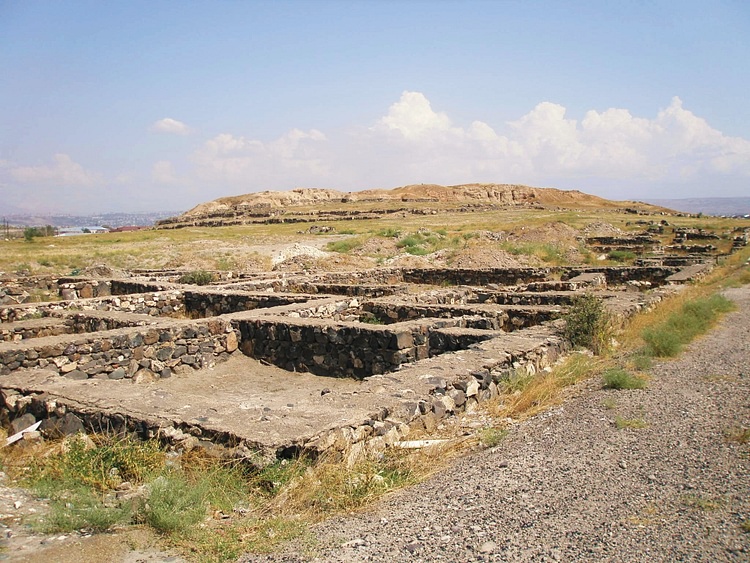
Teishebaini (aka Tesebaini, modern Karmir-Blur, near Yerevan, Armenia ) was an important fortress city of the Urartu civilization and excavations at the site, largely undisturbed since its abandonment c. 590 BCE, have provided an invaluable insight into the daily life of the region during the Bronze and Iron age of the 9th to 6th century BCE. With huge walls, large storerooms, granaries, wine and beer vats, along with many specialised workshops packed with artefacts, Teishebaini was a thriving production centre and focal point of Urartian wealth and military power.
FOUNDATION & HISTORY
The Urartu civilization flourished between the 9th and early 6th century BCE in ancient Armenia, eastern Turkey, and northwestern Iran. The fortress city of Teishebaini, located on the Ararat Plain, was founded by king Rusa II (rc 685-645 BCE) and was named after Teisheba, the Urartian god of storms and thunder. Today the site is called Karmir-Blur, and it is located near the current capital of Armenia, Yerevan.
The city, a regional capital and seat of a viceroy, primarily functioned as an important fortress which helped maintain the rule of the Urartian kings over their empire. Inscriptions attest to the frequent visits by the king and the religious sacrifices that then had to be made in his honour. Artefacts of varying dates and carrying dedicatory inscriptions naming different kings suggest that such precious goods had been transferred from other Urartian sites once Teishebaini had been completed. The sheer volume of the site's food storage capacity, much larger than needed for its own residents, indicates that Teishebaini was also an important administrative and economic centre in the region.
TEISHEBAINI COVERED AN AREA OF 400,000 SQUARE METRES (100 ACRES), WITH THE ROYAL PALACE ALONE BOASTING 120 ROOMS.
Finds of three-pronged arrowheads, typical of Scythian archers, found at the destroyed site of Teishebaini are suggestive. The destruction of the city first by military attack and then by fire sometime between 594 and 590 BCE seems to have been unexpected, with granaries recently filled and weapons and precious belongings seemingly abandoned in a hurry. The territories the Urartu kingdom had once occupied were ultimately taken over by the Medes from c. 585 BCE onwards and then incorporated into the Achaemenian Empire by Cyrus the Great in the mid-6th century BCE. Some Urartian cities continued to be inhabited into later times but Teishebaini was definitively abandoned in the early 6th century BCE.

Urartu
ARCHAEOLOGICAL EXCAVATIONS
Discovery
Teishebaini was only rediscovered in 1939 CE when Russian and Armenian archaeologists successfully followed a trail of artefacts and inscriptions which pointed to a settlement on a large mound in the outskirts of Yerevan. Handily, for the purposes of identification, a bronze belt and a ringed bolt were both inscribed in cuneiform with, “Rusa Argishtihini, fortress of the city of Teishebaini”. With both of these objects being portable, and so possibly from another fortress site, confirmation would have to wait until a doorway and a section of wall were excavated with matching inscriptions. The mound did indeed contain the ruins of Teishebaini. Once found, archaeologists struggled to know exactly where to begin in their excavations, but chance was to provide a helping hand, as the chief archaeologist Boris Piotrovsky explains:
…work was brought to a standstill by heavy rain; and on the following morning the whole layout of the fortress was visible on the ground. The walls of adobe brick retained the water longer than the earth filling and showed up clearly as darker outlines on the ground. (136)
Architecture
The site was revealed to cover an area of 400,000 square metres (100 acres), with the royal palace alone boasting 120 rooms and an area of 40,000 square metres. There were workshops, storerooms, wine cellars, granaries, housing and courtyards.Remains of the lower courses and foundations of the fortress' towers survive and are formed of very large basalt blocks. The towers were square and the walls buttressed at intervals. The walls were up to 3.5 metres (12 feet) thick in places and possibly up to 7 metres high. The wall facing the river had several square projections outwards, and the whole complex was built in a stepped arrangement over the various levels and contours of the natural citadel. Access to the interior of the fortress was provided by means of a ramp on the south-western side, a massive South Gate and a postern gate in the north-west corner (it was this gate which bore the brunt of the attack which destroyed the city).
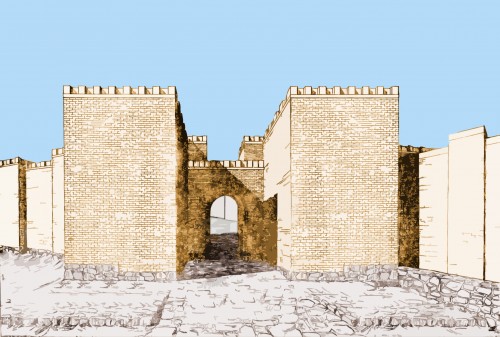
South Gate Reconstruction, Teishebaini
Some roofs of the buildings were made of wooden beams (eg pine, poplar or beech) and supported by wooden columns while others had barrel-vaulted roofs made from large adobe bricks. Doorways were made from thick wooden planks and fastened by means of a hinged bronze latch. The settlement was provided with fresh water via a canal running from the Ildaruni River and which went through a tunnel made into the basalt walls of the fortress.
There were private homes of various sizes and with a differing number of rooms, indicating they belonged to different social classes. Some buildings had two or three stories, and all were laid out in a regular plan suggesting that Teishebaini was purpose-built for a population who moved in upon completion.
The Storage Rooms
Once the walls were excavated and a general plan ascertained, excavations began to go deeper into the site. Piotrovsky here describes his impression when one storeroom first saw daylight again:
There was an atmosphere of desolation in the palace. There were wasps's nests and skeletons of mice, and in one of the jars the skeletons of a mouse and a cat were found. The cat it seems chased the mouse into the jar and both found themselves trapped because of its depth. When the the dust of centuries had been removed, the warehouses gave the impression of having only recently been occupied. Jars full of corn, bowls, lamps of clay, iron knives - all tidily laid out. And no one had lived there for over 2500 years. (quoted in Chahin, 101)
Many of the large storage jars of Teishebaini were sunk into the floors of the storerooms. With each jar inscribed with its contents in cuneiform, they had an impressive combined capacity of 150,000 litres (40,000 gallons). These jars, often still containing organic remains, were used to store wheat, barley, millet, grapes, oil and sesame. Six wine stores had a capacity of 34,000 litres (9,000 gallons). Beer was brewed from barley which was fermented in large vats covered with straw and branches and then stored in elongated and round-bottomed jars.

Urartian Beer Pitchers
Yet another room was dedicated to the production of sesame oil and included a large tufa vat in which the seeds were first soaked before pressing. Finds of large churns with fitted wedges indicate that cheese and butter were also made.
One room at the fortress contained the neck and breast parts of 26 cattle. Another room was filled with the burned remains of young animals with their heads and extremities missing. Both of these rooms indicate the extent of animal sacrifice in the Urartu religion. Meanwhile, whole skeletons of cattle, horses, asses, and sheep found elsewhere show that animal husbandry was carried out on a significant scale at the site. One record lists precisely the manufacture of by-products such as wool and skins.
Workshops seem to have been dedicated to specific materials, one, for example, contained only stag horns and iron saws, another had loom weights, spindles, and a carbonised roll of cloth. Outside the citadel, there were workshops dedicated to pottery and metalwork. All of the stored and manufactured goods at the site were meticulously accounted for on inscribed clay tablets. In addition, many of the storerooms had their doors sealed with a knotted rope covered in clay and impressed with two official seals.
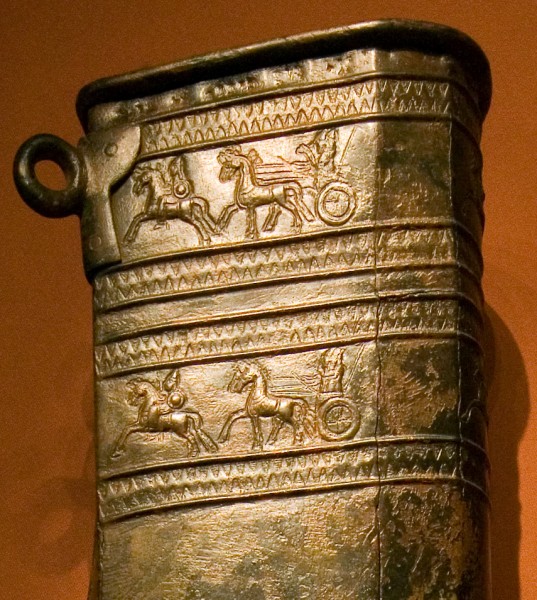
Urartu Decorated Quiver
Artefacts
As a testimony to Teishebaini and Urartu's position as an important regional trading centre, many artefacts have been discovered at the site which are of foreign origin. These include Assyrian cylinder seals, a faience amulet from Egyptinscribed with hieroglyphics, a faience vessel typical of those from Rhodes, Scythian horse-bits, and gold jewellery from Asia Minor.
Regarding Urartian artefacts, a huge quantity of bronze and iron weapons have been excavated at Teishebaini, and they include swords, daggers, arrows, spears, helmets, shields, and quivers, many often incised with decorative scenes, especially of lions and bulls. There were statues of gods; a fish-man and a scorpion-man figurines; bronze cauldrons with ornate three-dimensional decorations around the rim; and large quantities of red polished pottery (especially jugs), with rarer examples of black pottery. One unusual form of Urartian pottery is the vessel made in the shape of a boot, complete with painted stitching and laces. Several examples have been excavated from Teishebaini, and they date to the 8th century BCE. Jewellery finds include bronze fibulas, sardonyx and carnelian beads, silver medallions, and gold bracelets, earrings, and necklaces. There were 87 bronze cups neatly stacked in one room, many inscribed with a king's name and an emblem of a fortified tower and a tree. Finally, there is a fine ivory statue and another figurine in bronze of Teisheba, the god who gave his name to this remarkable fortress site.
This article was made possible with generous support from the National Association for Armenian Studies and Researchand the Knights of Vartan Fund for Armenian Studies.
LICENSE:
Article based on information obtained from these sources:with permission from the Website Ancient History Encyclopedia
Content is available under License Creative Commons: Attribution-NonCommercial-ShareAlike 3.0 Unported. CC-BY-NC-SA License